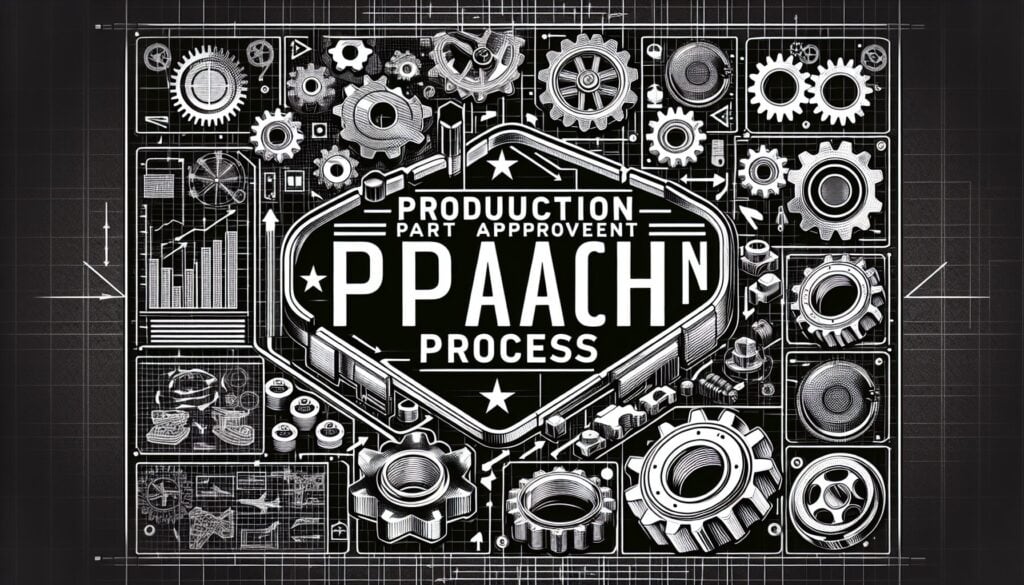A standardized process in the automotive and aerospace industries (and others) that ensures suppliers can consistently produce parts that meet the customer’s engineering design record and specification requirements.
- Méthodologies : Clients et marketing, Économie
PPAP (Production Part Approval Process)

PPAP (Production Part Approval Process)
- Planification avancée de la qualité des produits (APQP), Capacité de traitement, Amélioration des processus, Processus d'approbation des pièces de production (PPAP), Assurance qualité, Contrôle de qualité, Gestion de la qualité, Système de gestion de la qualité (SMQ), Pouvoir des fournisseurs
Objectif :
Comment il est utilisé :
- The supplier compiles a package of documents and samples (the PPAP package) providing evidence that their manufacturing process can consistently produce parts meeting all requirements. This package is submitted to the customer for approval before full production begins.
Avantages
- Ensures clear communication of requirements between customer and supplier; Verifies supplier's understanding and capability to meet requirements; Reduces risks of non-conforming parts in production; Provides objective evidence of capacité du processus.
Inconvénients
- Can be very document-intensive and time-consuming for suppliers; Requirements can be complex and vary between customers; Any changes to product or process often require re-submission, adding to workload.
Catégories :
- Fabrication, Qualité
Idéal pour :
- Ensuring that suppliers' production processes are capable of consistently producing parts that meet all customer specifications before mass production.
PPAP is widely utilized in automotive, aerospace, and manufacturing industries, where the precise quality of parts is paramount. This methodology is particularly relevant during the transition from prototype to mass production, ensuring that any parts submitted can meet the design specifications and regulatory standards expected by the customer. Participants typically include suppliers, quality assurance teams, and engineering personnel from both the supplier and customer sides, creating a collaborative environment for clarity and mutual understanding. Key components of the PPAP package may include design records, engineering change documents, process flow diagrams, control plans, measurement systems analysis, and initial sample inspection reports. These documents serve to verify that all production processes are capable of producing conforming product consistently, offering a systematic approach to quality management. Engaging in this process can preemptively address potential discrepancies, thus minimizing the likelihood of costly production delays or recalls caused by non-conforming products. The adoption of PPAP enhances transparency and trust, as both suppliers and customers are committed to fulfilling agreed-upon quality benchmarks, fostering a strong partnership built on accountability and shared objectives in delivering quality outcomes.
Principales étapes de cette méthodologie
- Review customer specifications and requirements.
- Conduct a process flow diagram analysis.
- Complete the Process Failure Mode and Effects Analysis (PFMEA).
- Establish control plans for the manufacturing process.
- Perform measurement system analysis (MSA).
- Validate product design through dimensional and functional testing.
- Submit the PPAP package including samples and documentation.
- Address any customer feedback or requests for additional information.
- Receive customer approval for the PPAP submission.
- Commence full production upon approval confirmation.
Conseils de pro
- Implement real-time monitoring and data collection during initial production runs to identify variations early in the process.
- Use advanced statistical tools such as Control Plans and Process Flow Diagrams to document and analyze production processes extensively.
- Establish a multi-disciplinary team involving design, quality, and manufacturing engineers during PPAP preparation to ensure thoroughness in each aspect of part production.
Lire et comparer plusieurs méthodologies, nous recommandons le
> Référentiel méthodologique étendu <
ainsi que plus de 400 autres méthodologies.
Vos commentaires sur cette méthodologie ou des informations supplémentaires sont les bienvenus sur le site web de la Commission européenne. section des commentaires ci-dessous ↓ , ainsi que toute idée ou lien en rapport avec l'ingénierie.
Contexte historique
1949
1950
1950
1960
1960
1960
1960
1940
1950
1950
1958
1960
1960
1960
1960
(si la date est inconnue ou n'est pas pertinente, par exemple "mécanique des fluides", une estimation arrondie de son émergence notable est fournie)















Articles Similaires
Questionnaires sur les troubles musculo-squelettiques
Tests à plusieurs variables (MVT)
Analyse de régression multiple
Systèmes de capture de mouvement
Méthode MoSCoW
Test de la médiane de Mood